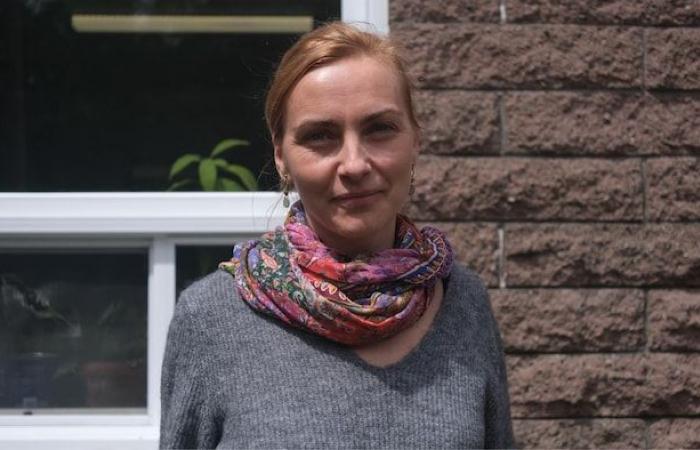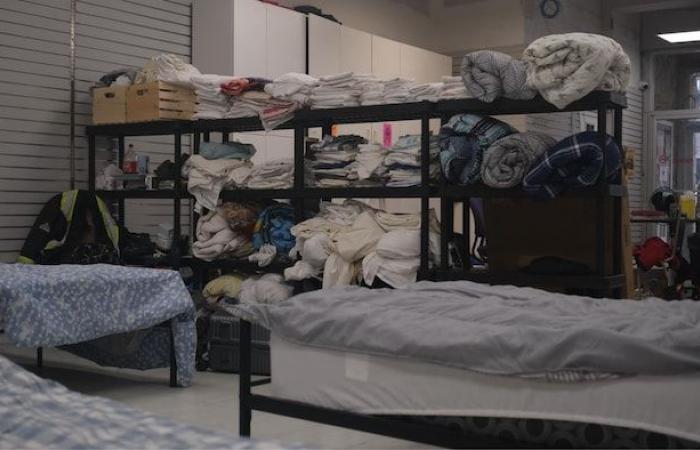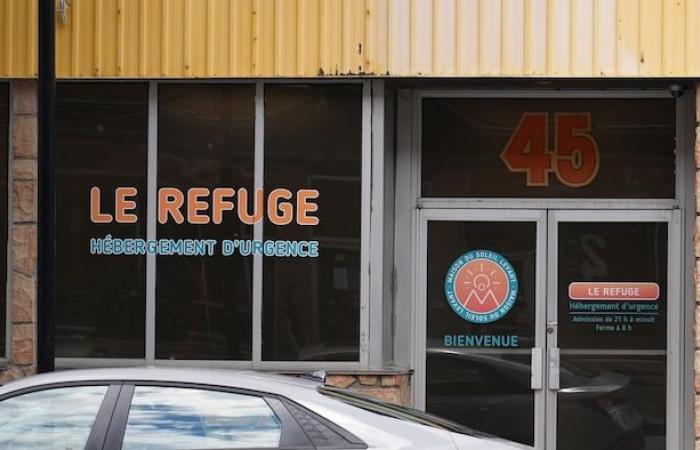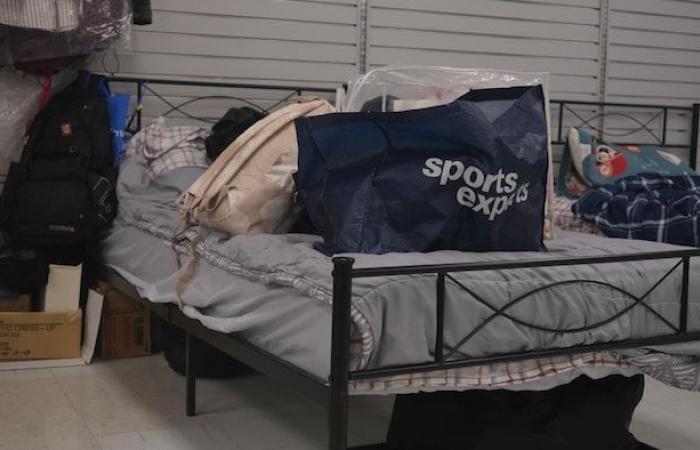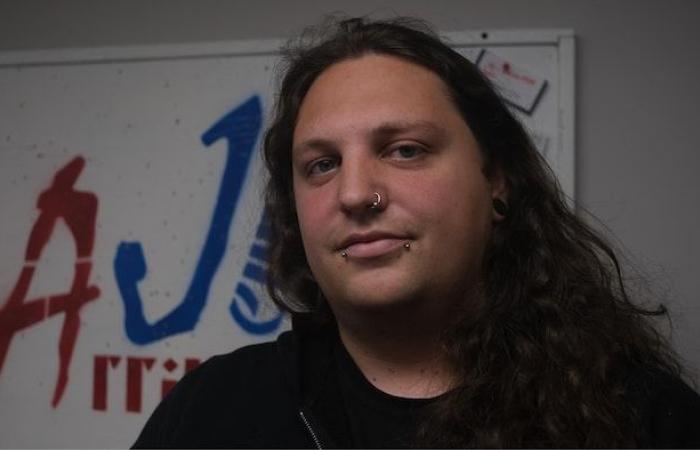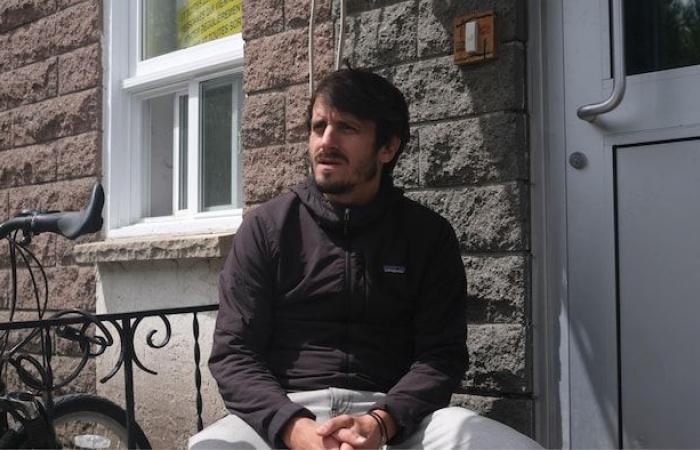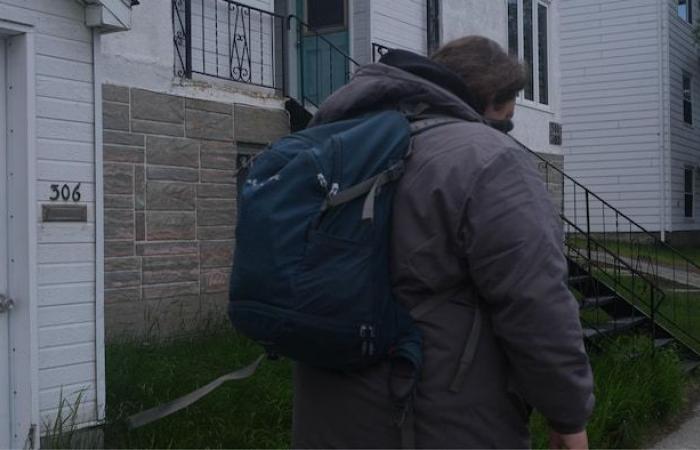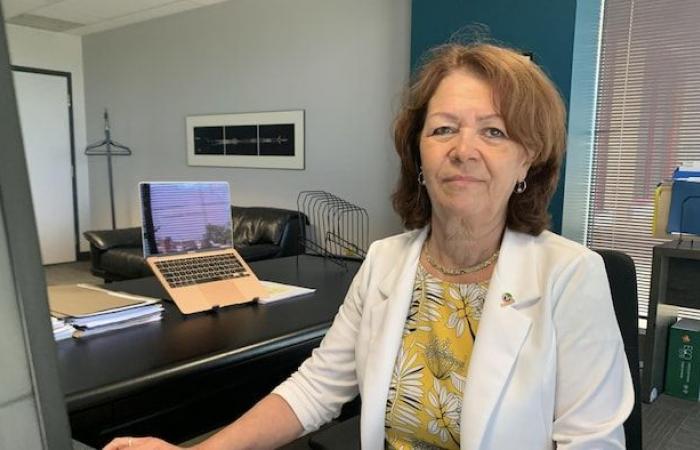Marc-André Guénette has been attending the Maison du Soleil levant shelter for two months, opened in January on rue Perreault Est in Rouyn-Noranda. Being downtown – rather than in her mother’s trailer outside of town – helps her organize her days and prepare for her return to work.
I am closer to make my appointments and last minute sessions, he mentions. I was thumbing my thumb when I was stuck in my trailer.
Open in full screen mode
Marc-André Guénette does various odd jobs at the shelter to help out and to occupy his free time.
Photo: Radio-Canada / Gabriel Poirier
Marc-André is not the only one to have found himself on the street in recent months.
Bailiffs in the region confirm, with supporting data, that evictions for unpaid rent have been on the rise since the start of the COVID-19 pandemic. This is true in Rouyn-Noranda, but also everywhere in Abitibi-Témiscamingue.
End of widget. Return to start of widget?
While these evictions do not necessarily fuel homelessness, several social workers are issuing a warning. They claim that the phenomenon is getting worse, in addition to becoming more and more visible.
Homelessness and its amplification is first and foremost a housing crisis
, says Guillaume Daraignez. The clinical coordinator at the Maison du Soleil levant, in post for two years, is preparing to return to France in June, which does not prevent him from denouncing hyperprivatization
of the real estate sector, where several doors are now reserved for tourists and seasonal workers.
Open in full screen mode
La Maison du Soleil levant also offers temporary accommodation in its premises on Reilly Street for people experiencing homelessness.
Photo: Radio-Canada / Jessica Gélinas
The City of Rouyn-Noranda has started to regulate Airbnb accommodation, except that the concerns of the community remain unresolved. The private housing that is being built, for their part, does not allay fears, because it is unaffordable for vulnerable people.
The housing crisis is a structural problem, but it is not a structural problem decided by an almighty God. It is human society that decides that we can speculate in real estate and it is human society that decides that we can go all out on AirBnb and let a few companies control the market.
The average rent is $793 per month in Rouyn-Noranda, according to the Canada Mortgage and Housing Corporation, while 4 ½s from the real estate company Trilogis oscillate online between $1,400 and $2,000 per month.
In Rouyn-Noranda, the rental vacancy rate was 0.8% last October, far from the equilibrium rate of 3%. This means that the housing crisis has been plaguing the region for nearly twenty years.
Cohabit
Homelessness in the city center forces citizens of different classes to live together.
This is one of the points that coordinator Aline Dunoyer, newly arrived at the House of the Rising Sun to replace Guillaume Daraignez, invites us to keep in mind. Especially since tensions are rising in the city center, to the point that the strategic committee has concocted a first action plan to regulate the phenomenon of homelessness during the summer of 2024.

Open in full screen mode
“They are people in their own right and not a problem to be solved,” warns Aline Dunoyer.
Photo: Radio-Canada / Gabriel Poirier
How do we accommodate people experiencing homelessness? How do we ensure that they can remain safe and have dignified living conditions, despite the difficulties they encounter? These are questions that I ask myself as a social worker, but also as a member of the community
explains Ms. Dunoyer, for whom each person on the street has a unique story.
The downtown shelter better responds to demand, but the fact remains that the efforts of stakeholders to alleviate human suffering continue to take place downstream, according to street worker Hubert Collard.
-
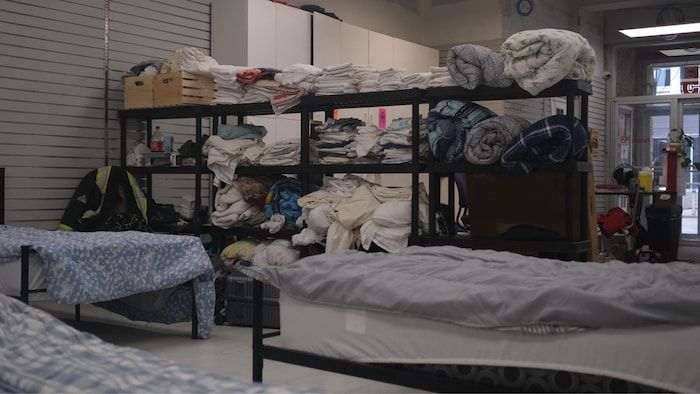
Open in full screen mode
The night shelter is almost always full according to the speakers at the Maison du Soleil levant.
Photo: Radio-Canada / Gabriel Poirier
-
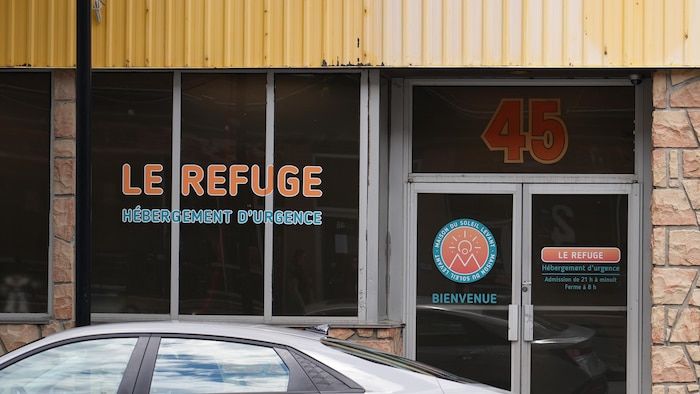
Open in full screen mode
The day center and night shelter of the Maison du Soleil levant are located on rue Perreault Est in Rouyn-Noranda.
Photo: Radio-Canada / Jessica Gélinas
-

Open in full screen mode
The day center in the city center is called the Cabin.
Photo: Radio-Canada / Gabriel Poirier
-
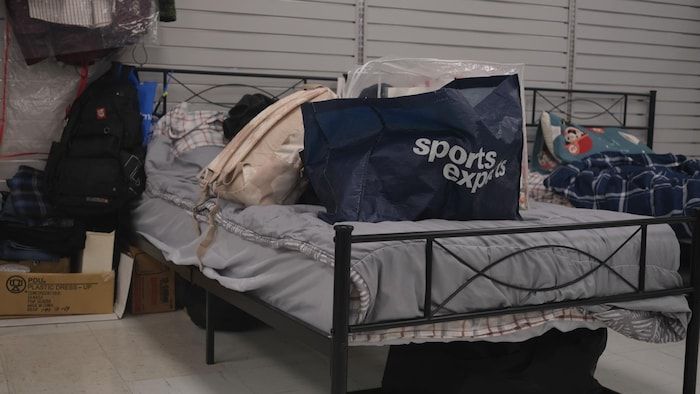
Open in full screen mode
A user keeps what he has left on his bed.
Photo: Radio-Canada / Gabriel Poirier
The day center and night shelter of the Maison du Soleil levant are located on rue Perreault Est in Rouyn-Noranda.
Photo: Radio-Canada / Jessica Gélinas
The night shelter is almost always full according to the speakers at the Maison du Soleil levant.
Photo: Radio-Canada / Gabriel Poirier
Photo album: Rouyn-Noranda homeless shelter
It is also the street that is changing before Hubert Collard’s eyes, a way of saying that poverty, homelessness and drug consumption are increasing according to him. The latter travels through the neighborhoods of Rouyn-Noranda to observe the field, try to identify developments and to establish links with people who are excluded from traditional services.
And unless the housing supply is improved, he doesn’t expect things to change anytime soon.

Open in full screen mode
Hubert Collard has been walking the streets of Rouyn-Noranda on behalf of the organization Arrimage Jeunesse for three years. The services it offers are informal, without monitoring and without reporting.
Photo: Radio-Canada / Gabriel Poirier
I often like to say that we are the first entry point for services, but also the last. I help people who are very well adjusted and just don’t know where to turn. Conversely, I also help people who experience homelessness, stigma and who are barred from several organizations. I can mediate to help them obtain services
he says.
People in difficulty
One thing is certain, the speakers insist on reminding us that the phenomenon of homelessness is not new in Rouyn-Noranda. It is simply more visible now that services are offered downtown.

Open in full screen mode
Guillaume Daraignez believes that homelessness is increasing and evolving. The suffering experienced today is no longer the same as in the 1970s.
Photo: Radio-Canada / Gabriel Poirier
1970 answers the question. Homelessness has existed for a long time.”,”text”:”People in difficulty, disaffiliated people, relegated people, they have existed since society became industrialized, adds Mr. Daraignez. The mere existence of the House of the Rising Sun since the late 1970s answers the question. Homelessness has been around for a long time.”}}”>People in difficulty, disaffiliated people, relegated people, they have existed since society became industrialized, adds Mr. Daraignez. The mere existence of the House of the Rising Sun since the late 1970s answers the question. Homelessness has been around for a long time.
When people say that homelessness didn’t exist, they have their words wrong. I offer them another one. Before, we didn’t see it.
It’s true that people who live on the streets take over different spaces, except that they do it to survive
adds Aline Dunoyer.
Towards 200 social housing units
From one stakeholder to another, we usually rely on public authorities to reduce social disparities, bring together the community and build social housing.
The public authority must intervene and private initiatives must emerge. In a city like Rouyn-Noranda, frankly, we can almost overcome the problem of homelessness, believes Mr. Daraignez. We will not overcome individual suffering, but it is our job to welcome them.
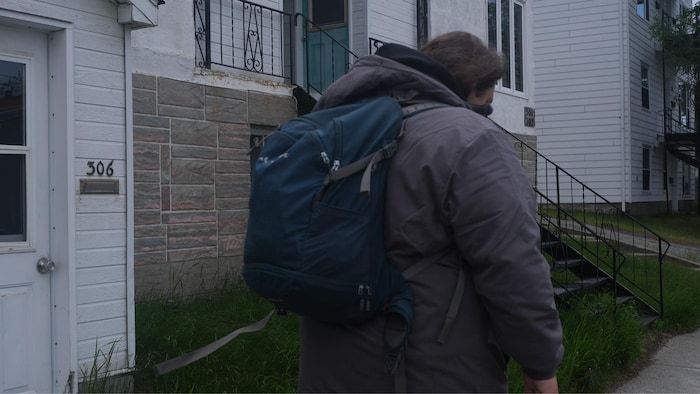
Open in full screen mode
With his backpack, Hubert Collard travels the streets to offer listening and support to those he meets or those who question him.
Photo: Radio-Canada / Gabriel Poirier
The mayor of Rouyn-Noranda, Diane Dallaire, also relies on other levels of government since Quebec and Ottawa finance social housing. Beyond the housing shortage, Ms. Dallaire thinks that individual factors
fuel the rise in homelessness, poverty, conflict and breakdown, health problems and violence.
We really feel that the government is listening well, because the situation is everywhere in the province.
she declares.
She cites as an example the 200 new social housing units planned in Rouyn-Noranda, announced by the Quebec government.
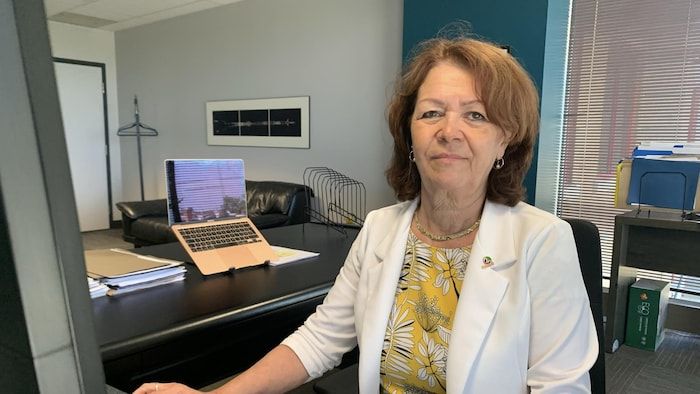
Open in full screen mode
Diane Dallaire also salutes the work of the member for Rouyn-Noranda–Témiscamingue, Daniel Bernard, whom she describes as an ally.
Photo: Radio-Canada / Gabriel Poirier
We must also name the additional challenge, for Rouyn-Noranda, of moving 200 families [de la future zone tampon]. It adds pressure
she assures.
This forced relocation of 200 families from the Notre-Dame district worries those mainly concerned, but the mayor of Rouyn-Noranda wants to be reassuring. She maintains that everything is in place to prevent them from ending up on the street.
While waiting for the construction of social housing, the Maison du Soleil levant intends to keep its night shelter in the city center, but move its day center. People experiencing homelessness should therefore be less visible, without the number of people on the streets decreasing.



